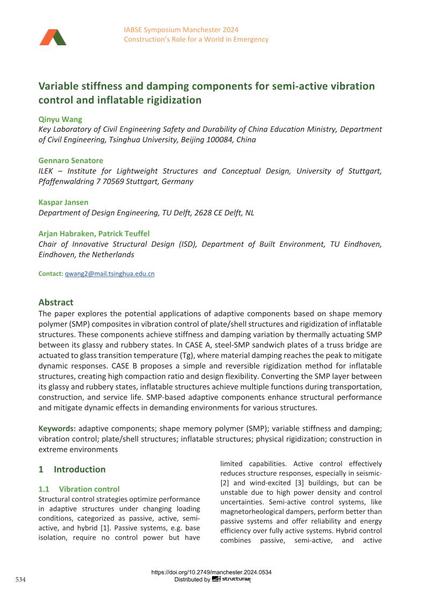Variable stiffness and damping components for semi-active vibration control and inflatable rigidization

|
|
|||||||||||
Bibliografische Angaben
| Autor(en): |
Qinyu Wang
(Key Laboratory of Civil Engineering Safety and Durability of China Education Ministry, Department of Civil Engineering, Tsinghua University, Beijing 100084, China)
Gennaro Senatore (ILEK – Institute for Lightweight Structures and Conceptual Design, University of Stuttgart, Pfaffenwaldring 7 70569 Stuttgart, Germany) Kaspar Jansen (Department of Design Engineering, TU Delft, 2628 CE Delft, NL) Arjan Habraken (Chair of Innovative Structural Design (ISD), Department of Built Environment, TU Eindhoven, Eindhoven, the Netherlands) Patrick Teuffel (Chair of Innovative Structural Design (ISD), Department of Built Environment, TU Eindhoven, Eindhoven, the Netherlands) |
||||
|---|---|---|---|---|---|
| Medium: | Tagungsbeitrag | ||||
| Sprache(n): | Englisch | ||||
| Tagung: | IABSE Symposium: Construction’s Role for a World in Emergency, Manchester, United Kingdom, 10-14 April 2024 | ||||
| Veröffentlicht in: | IABSE Symposium Manchester 2024 | ||||
|
|||||
| Seite(n): | 534-542 | ||||
| Anzahl der Seiten (im PDF): | 9 | ||||
| DOI: | 10.2749/manchester.2024.0534 | ||||
| Abstrakt: |
The paper explores the potential applications of adaptive components based on shape memory polymer (SMP) composites in vibration control of plate/shell structures and rigidization of inflatable structures. These components achieve stiffness and damping variation by thermally actuating SMP between its glassy and rubbery states. In CASE A, steel-SMP sandwich plates of a truss bridge are actuated to glass transition temperature (Tg), where material damping reaches the peak to mitigate dynamic responses. CASE B proposes a simple and reversible rigidization method for inflatable structures, creating high compaction ratio and design flexibility. Converting the SMP layer between its glassy and rubbery states, inflatable structures achieve multiple functions during transportation, construction, and service life. SMP-based adaptive components enhance structural performance and mitigate dynamic effects in demanding environments for various structures. |
||||
